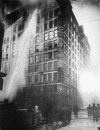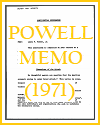| Triangle Fire, PBS: American Experience Educator Guide |
|---|
| www.studenthandouts.com ↣ U.S. History ↣ Discontent and Reform ↣ Books and Films |
 |  |  |  |  |
| 1. Have students locate the Asch Building (now known as the Brown Building) on Google Maps. The address is 23-29 Washington Place, New York, NY 10003. Once the building has been pinpointed, have students locate other sites nearby that are mentioned in the documentary, such as Washington Square Park. 2. After watching this DVD video, have students (working in groups) imagine that they are government officials dealing with the public outcry following this tragedy. Tell them that they have been called upon to enact legislation that will prevent another such tragedy from occurring in the future. Have the student groups compile lists of their new rules. compare the students' rules with current workplace safety regulations. 3. Were the factory owners criminally responsible for the deaths that occurred? Have students (working in two groups) examine the evidence (available here and here) and debate the issue, with half of the class defending the owners, and half of the class prosecuting the owners. Pose the question, "Would the trial receive a different verdict today? Why or why not?" 4. Assign an individual victim to each student (names and biographical information are available here). Using a rubric of guidelines (such as name, date of birth, age, place of residence, country of origin, method of death), have students create tombstones for their assigned victims. If possible, these tombstones can be used to create a cemetery that can be toured by other students in order to educate them on this tragedy. 5. Have students read aloud the commemorative poem written by Morris Rosenfeld four days after the fire, available here. Vocabulary terms: agitating, corpse, criminal trial, dangerous working conditions, docked pay, economic security, elevator operator, fire escape, garment industry, general strike, Gilded Age, Greenwich Village, grievances, immigrants, individualism, industrial machine, industrialists, labor movement, legislation, Lower East Side, Manhattan, morgue, New York City, sweatshops, technology, tenement, Triangle Waist company, unionization, Washington Square Park The Triangle Shirtwaist Factory fire, which occurred on March 25, 1911, was one of the deadliest industrial disasters in American history. Background: The Triangle Shirtwaist Factory was a clothing factory located on the eighth, ninth, and tenth floors of the Asch Building in New York City. It employed predominantly young immigrant women who worked long hours in poor conditions. The factory's owners, Max Blanck and Isaac Harris, were known for their cost-cutting measures and had a history of labor violations. The Fire: On the fateful day, a fire broke out on the eighth floor of the factory in the late afternoon. The exact cause of the fire remains unknown, but it is believed to have been sparked by a discarded cigarette or a malfunctioning sewing machine. The factory was filled with highly flammable materials, including piles of cotton scraps, and the fire spread rapidly. Trapped Workers: As the fire quickly engulfed the factory, panic and chaos erupted among the workers. Many were unable to escape due to locked doors and blocked exits. The factory's owners had locked the stairwell doors to prevent theft and unauthorized breaks, and the one available fire escape soon became unusable due to the intense heat and overcrowding. Some workers attempted to use the elevator, but it could not carry the load of panicked individuals and malfunctioned. Horrific Loss of Life: Tragically, 146 workers, mostly young women, lost their lives in the fire. Some perished from the flames, while others succumbed to smoke inhalation or by jumping from the upper floors to escape the inferno. The horrifying scene of workers jumping to their deaths was witnessed by crowds on the street below. Aftermath: The Triangle Shirtwaist Factory fire shocked the nation and galvanized the labor and reform movements. It prompted widespread outrage and calls for improved safety standards and workers' rights. It also led to significant changes in labor laws and workplace safety regulations. Immediate Reforms: In the wake of the fire, the New York State Legislature created a Factory Investigating commission to examine workplace conditions and recommend improvements. This commission's findings resulted in the passage of new labor laws, including regulations on fire safety, building codes, and worker safety. Legacy: The Triangle Shirtwaist Factory fire is often credited with advancing the labor and workplace safety movement in the United States. It served as a catalyst for significant reforms that sought to protect workers' rights, improve working conditions, and ensure fire safety. The tragedy underscored the importance of government regulation and oversight to protect the well-being of workers, and it remains a poignant reminder of the human cost of industrial negligence and exploitation. |
 |  |  |  |  |  |
| www.studenthandouts.com ↣ U.S. History ↣ Discontent and Reform ↣ Books and Films |









